Site of the Ni'ihau Incident
A Japanese pilot crash-landed on this Hawaiian island after the Pearl Harbor attack and terrorized locals for a week.
When Japan attacked Pearl Harbor on December 7, 1941, the island of Ni’ihau was inhabited by a mere 136 souls, most of whom were Native Hawaiians. Out of those who weren’t, three happened to be of Japanese descent.
Because of the island’s small size and significant isolation, the Imperial Japanese Navy mistakenly characterized the area as uninhabited, and designated it as a place to crash land and/or rendezvous with a rescue sub after the onslaught.
Airman First Class Shigenori Nishikaichi’s plane was damaged after taking part in the second wave of the attack, and as he had been instructed, crash landed on the deserted Ni’ihau. Much to his surprise he was approached by a Ni’ihau resident who had been standing just a few feet away. While unaware of the attack on Pearl Harbor, the resident knew enough about current events to relieve Nishikaichi of his weapon and his papers.
Unable to communicate with the pilot and confused about his presence, the Japanese-speaking residents were summoned. Yoshio Harada, who was Hawaiian-born but of Japanese descent, was brought in along with his wife Irene to speak to the pilot. After a terse conversation in which Nishikaichi informed the two of the Pearl Harbor attack, Harada chose to keep the info to himself, and asked if the pilot could be relocated to his house until someone from the main island came to fetch him.
The absence of electricity and telephones on the island delayed news of the fate of Pearl Harbor, but a radio transmission alerted the people of Ni’ihau to the gravity of the presence of their prisoner eventually, and Nishikaichi knew that his lax security among these gentle and welcoming people would soon come to an end. Employing the help of the Haradas as well as the only other Japanese citizen on the island, Ishimatsu Shintani, he overpowered the guards, retrieved his weapon, and took a 16 year-old girl as a hostage.
For the next several days, Nishikaichi and his converts terrorized the island in a mission to retrieve the pilot’s papers, which Hawila Kaleohano, the man who had originally confiscated them, stubbornly refused to surrender. Women and children ran for caves and distant beaches as the men played an armed version of cat and mouse, Kaleohano hiding the papers with a relative and then setting out to get help as Nishikaichi frantically torched his plane and tore the island inside-out looking for his vital papers.
Finally, on December 13, six days after the madness had begun, it abruptly ended. Harada and Nishikaichi, desperate to find the papers, took Ben Kanahele and his wife hostage and ordered them to find Kaleohano. Aware that Kaleohano had left the island, Ben Kanahele played along. Noticing the exhaustion of his captors, he watched and waited for the perfect opportunity to pounce. At the earliest distraction, Kanahele and his wife Ella sprung into action, and despite getting shot three times, he managed to overpower Nishikaichi long enough for Ella to smash his head in with a rock. Harada, upon realizing his new leader was dead and his treason would be exposed, turned his shotgun on himself as Kanahele cut the pilot’s throat.
The privately owned island of Ni’ihau is still fairly isolated to this day, open primarily to residents, their invited guests and military personnel, giving it the nickname “The Forbidden Isle”. Since 1987, it has allowed limited tourism and supervised excursions on its shores. The remains of Nishikaichi’s Zero can be viewed on permanent display at the Pacific Aviation Museum on Ford Island in Pearl Harbor.



















Follow us on Twitter to get the latest on the world's hidden wonders.
Like us on Facebook to get the latest on the world's hidden wonders.
Follow us on Twitter Like us on Facebook